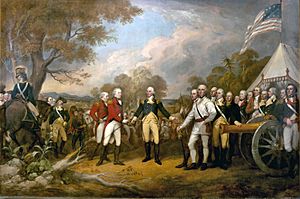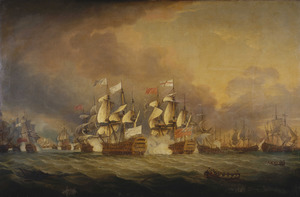France in the American Revolutionary War facts for kids
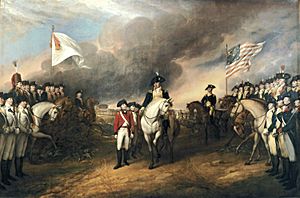
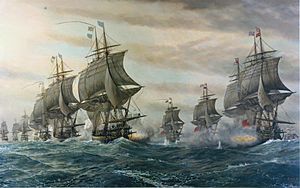
France's help in the American Revolutionary War (1775–1783) started in 1776. At first, the Kingdom of France secretly sent supplies to the Continental Army of the Thirteen Colonies. France and Great Britain had been enemies for a long time. The American Colonies were trying to break away from British rule.
In 1778, France and the Continental Army signed a treaty. This led to France sending money, equipment, and soldiers to the United States. Soon after, a global war began with Britain. Later, Spain and the Dutch Republic also started helping. This meant Britain had no allies during the conflict, except for some German soldiers called Hessians. Spain officially joined the war in 1779, and war between Britain and the Dutch followed.
France's support was a huge reason why the United States won the war and gained independence. However, France spent over 1 billion livres (French money) on the war. This caused big money problems for the country. The French government's money troubles, along with other issues, led to the French Revolution a few years later. After the American war, relations between France and the United States also got worse, leading to the Quasi-War in 1798.
Contents
Why the American Revolution Started
After losing the Seven Years' War in 1763, France lost all its lands in North America. Meanwhile, American colonists and the British government began to argue. They disagreed about who had the right to collect taxes: the British Parliament in London or the colonial assemblies. For example, the colonists held the Boston Tea Party to protest a tea tax.
Britain reacted by passing the Intolerable Acts. These laws closed Boston Harbor and took away Massachusetts's colonial charter. This made tensions even worse. The arguments turned into open fighting in 1775, when American patriots rebelled against British rule. France had been rebuilding its army and navy. They saw this as a perfect chance to get revenge on Britain and weaken their old enemy.
France Joins the Fight
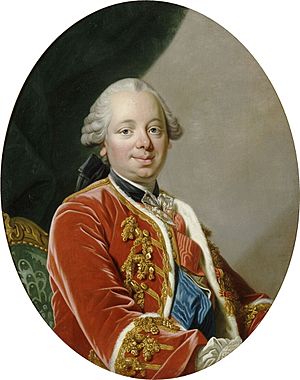
France was very upset about losing the Seven Years' War and wanted revenge. They also wanted to make Britain weaker. When the Declaration of Independence was signed, people in France, both commoners and nobles, were excited about the American Revolution. They saw it as a fight for freedom against "English tyranny."
Benjamin Franklin went to France in December 1776 to get their support. He was welcomed with great excitement. At first, France's help was secret. French agents sent military aid, mostly gunpowder, to the Americans. This started in the spring of 1776 through a company called Rodrigue Hortalez et Compagnie. It's thought that up to 90% of the weapons used by Americans in the Saratoga campaign came from France. By 1777, over five million livres of aid had been sent to the American rebels.
Many French volunteers joined the American army. They were either looking for glory or believed in liberty. One famous volunteer was Lafayette. He was a young nobleman who joined in 1777 at age 20, even though the king told him not to. He became an important helper to George Washington and a general. Lafayette helped Americans see France in a good way. He was charming, learned quickly, and became a close friend of General Washington.
Should France Help Secretly or Openly?

The new American nation needed weapons and allies to fight the powerful British. So, they turned to France. France wasn't directly involved in the American conflict. But they saw it as a chance to challenge British power by helping Britain's enemy. Through talks, first by Silas Deane and then by Benjamin Franklin, France began secretly supporting the American cause.
King Louis XVI and France's foreign minister, the comte de Vergennes, secretly asked Pierre Beaumarchais to help. He was allowed to sell gunpowder and ammunition to the Americans. This was done through the French company Rodrigue Hortalez et Compagnie. The aid from France, much of which went through the neutral Dutch port of Sint Eustatius, helped George Washington's army survive in 1776 and 1777. This aid also played a big part in the British defeat at Saratoga. French ports also welcomed American ships, including privateers (armed ships owned by private people) and navy warships, which attacked British merchant ships. France gave a lot of money, as gifts or loans, and also offered military advice. Some French military experts took "vacations" to help American troops.
Silas Deane, an American representative, got unofficial help from France starting in early 1776. But the goal was for France to fully join the war. A new group, including Franklin, Deane, and Arthur Lee, was sent to get European nations involved. (The British even paid spies to watch them). Franklin, who was 70 and famous in France for his science, was the main diplomat. He dressed simply and met with many important people. Franklin became a symbol of the new American spirit in France.
By late 1777, the situation became more tense. Austria asked France for help in a war against Prussia. France said no, which made relations with Austria bad. So, Austria couldn't help France against Britain. Attempts to get Spain to join also failed at first. Spain didn't see immediate benefits and worried that the American revolution might inspire their own colonies to rebel.
Most people in France wanted open war. But King Louis and his advisors were worried about the risks and high costs. The king's money and military advisors were especially hesitant. The French Navy was being rebuilt quickly, but they weren't sure if it was ready for a big fight. Financial advisors like Turgot and Necker warned that war would be very expensive for France's weak tax system.
The Americans argued that an alliance of the United States, France, and Spain would quickly defeat the British. But Vergennes, waiting for his navy to be ready, hesitated. On July 23, 1777, Vergennes decided it was time to either fully help, which meant war, or abandon the new nation. The king agreed, and the choice was war.
France Enters the War
The British had taken Philadelphia in 1777. But the American victory at the Battle of Saratoga gave hope to the Patriots and excited people in France. The army of General Burgoyne surrendered to American forces after Saratoga. This made France realize that the United States could actually win. The king then told Vergennes to make an alliance with the Americans.
France officially recognized the United States on February 6, 1778, by signing the Treaty of Alliance. Soon after, Britain declared war on France on March 17, 1778. The British navy, which was the largest at the time, and the French navy began to fight. The British didn't stop a French fleet that left Toulon in April for North America. They were worried the French fleet at Brest might invade Britain. France kept the Brest fleet to protect its trade ships in Europe. It only sailed out after a British fleet left to chase the other French fleet. Even with this, the British fleet at Brest was still bigger. So, Admiral d'Orvilliers was told to avoid fighting when he sailed in July. D'Orvilliers met the British fleet in the Battle of Ushant on July 27. The battle was not decisive, and both fleets went back to port for repairs.
France thought about landing 40,000 soldiers in Britain. But they gave up the idea because it was too difficult to organize. In Europe, France was protected by its alliance with Austria. Even though Austria didn't join the American Revolutionary War, it supported France diplomatically.
Other European nations at first refused to openly join the war. But both Spain and the Dutch Republic gave unofficial help to the American cause. Vergennes convinced Spain to officially join the war in 1779. In 1780, Britain declared war on the Dutch Republic. Britain claimed the Dutch were breaking their neutrality.
Battles in North America
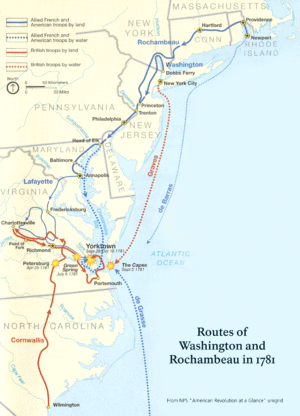
France's involvement in North America was mostly at sea. At first, their military leaders were a bit unsure. In 1778, American and French leaders planned to capture Newport, Rhode Island, which the British held. This attempt failed, partly because Admiral d'Estaing didn't land French troops before sailing out to meet the British fleet. He then sailed to Boston after a storm damaged his ships. In 1779, d'Estaing brought his fleet to North America again for joint operations. This time, they attacked British-held Savannah, Georgia. About 3,000 French soldiers joined 2,000 Americans in the Siege of Savannah. A naval attack didn't work. An attempt to storm the British positions failed with heavy losses.
French support became more important in 1780. About 6,000 soldiers led by Rochambeau landed at Newport. The British had left Newport in 1779, and the French set up a naval base there. These forces didn't do much at first because the British fleet watched them closely from New York. By early 1781, the war was dragging on. French military planners finally realized they needed bigger operations in North America to end the war.
That year, the West Indies fleet was led by the comte de Grasse. Special plans were made to work with him. De Grasse asked for North American pilots and information about possible operations. Rochambeau and Washington met in Wethersfield, Connecticut in May 1781 to discuss their options. Washington wanted to drive the British out of both New York City and Virginia. Virginia was seen as a big threat that could be fought with naval help. These two options were sent to the Caribbean with the pilots. Rochambeau, in a separate letter, urged de Grasse to come to the Chesapeake Bay for operations in Virginia. After the Wethersfield meeting, Rochambeau moved his army to White Plains, New York and put his command under Washington.
De Grasse got these letters in July, around the same time Cornwallis was getting ready to occupy Yorktown, Virginia. De Grasse agreed with Rochambeau. He sent a message saying he would reach the Chesapeake by the end of August. But he could only stay until mid-October because of agreements with the Spanish. When his messages arrived, the French-American army began marching to Virginia. De Grasse reached the Chesapeake as planned. His troops helped Lafayette's army block Cornwallis's army. A British fleet sent to challenge de Grasse's control of the Chesapeake was defeated by the French on September 5 at the Battle of the Chesapeake. The Newport fleet then brought the French siege equipment. The Siege of Yorktown and Cornwallis's surrender on October 19 were key in ending major fighting in North America.
Other Battles Around the World
Other important battles between the French and British happened all over the world. These included places from the West Indies to India. France's navy at first controlled the West Indies. They captured Dominica, Grenada, Saint Vincent, and Tobago. But they lost St. Lucia early in the war. After the siege of Yorktown, the French returned to the West Indies. They successfully took St. Kitts (even after a naval defeat), Montserrat, and Demerara and Essequibo in South America by February 1782. A planned French-Spanish invasion of Jamaica was stopped after the big Battle of the Saintes in 1782. This made French forces play defense in the Caribbean. However, the French captured the Turks and Caicos Islands at the end of the war.
In European waters, France and Spain joined forces when Spain entered the war in 1779. An attempted invasion of Britain failed for many reasons. A French invasion of Jersey ended in defeat. French and Spanish forces captured Minorca in February 1782. But the Great Siege of Gibraltar, the biggest operation of the war from 1779 to 1783, failed. They couldn't storm the place or stop the British from repeatedly supplying their soldiers.
In India, British troops took control of French outposts in 1778 and 1779. This led the Kingdom of Mysore, a long-time French ally, to start the Second Anglo-Mysore War. Allied with the French, the Mysoreans for a time threatened British positions on the east coast. A French fleet led by the Bailli de Suffren fought several battles with a British fleet. These battles were mostly undecided. The only major land battle, the 1783 Siege of Cuddalore, ended early. News arrived that a peace agreement had been signed. The French did not get back the lands they lost in India during the Seven Years' War. The British continued fighting with Mysore until that conflict ended in 1784.
Peace Talks
Because of the important battles in America, the French were in a strong position during the peace talks in Paris in early 1782. However, Rodney's victory at the Battle of the Saintes in April changed everything. News of the French defeat arrived in France nearly six weeks later and caused great sadness. The defeat was costly both militarily and financially. The Royal Navy now had the upper hand. As a result, British demands at the peace talks became much stronger. France was also running out of money to borrow and wanted the war to end quickly. The defeat also weakened the alliance between France and America. Because of this, Benjamin Franklin never told France about the secret talks that happened directly between Britain and the United States.
The British position became even stronger in September. The French-Spanish attack on Gibraltar was destroyed, and the Royal Navy supplied the garrison the next month. A first peace treaty between Great Britain and America was signed on November 30. Britain agreed that the United States owned all the land south of the Great Lakes and east of the Mississippi River, except for Florida (which went to Spain). The French accepted this preliminary treaty with protests but did not take action. Since France was not part of the American-British peace talks, France and Spain had less influence in future negotiations.
What Happened Next
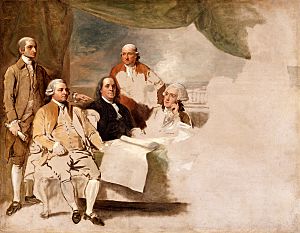
With the Americans separated from their allies, the war officially ended in September 1783. This happened with the signing of the Treaty of Paris. France did not get back the lands it lost in the 1763 Treaty of Paris and the Treaty of Utrecht (1713). All lands captured by the different powers were returned. The only exceptions were Tobago and part of the Senegal River area, which France gained. France also got some fishing rights in Newfoundland. Spain did better, getting back Florida and Minorca. But Gibraltar stayed with the British.
Because France's involvement in the war was far away and mostly naval, the French government spent over a billion livres tournois to help the war effort. This raised its total debt to about 3.315 billion. The French government's money situation was terrible. It got worse because Jacques Necker, instead of raising taxes, used loans to pay off debts. The finance minister, Charles Alexandre de Calonne, tried to fix the money problem by asking to tax the property of nobles and clergy. But he was fired and sent away for his ideas. This instability in France made it harder to fix the country's finances. Trade also dropped a lot during the war but got better by 1783.
The war was very important for France's pride. It helped France become a major power in Europe again. However, Great Britain, not France, became the main trading partner of the United States. The French were proud of their cultural influence on the young country through the ideas of the Enlightenment. This was seen in the Declaration of Independence in 1776 and the United States Constitution in 1787. In turn, the American Revolution influenced France. Liberal thinkers were happy about the victory. But there were also some big consequences. European royalists and nobles became nervous. They started taking steps to protect their positions. For example, on May 22, 1781, a new rule called the Decree of Ségur closed high military positions to common people, saving them only for nobles.
Money Matters
In total, France spent 1.3 billion livres to directly support the Americans. This was in addition to the money it spent fighting Britain on land and sea outside the U.S.
France's status as a great modern power was confirmed by the war. But it was very bad for the country's money. Even though France's lands in Europe were not affected, winning a war against Great Britain, with battles like the key siege of Yorktown in 1781, cost a lot. This severely damaged France's weak finances and increased its national debt. France gained little, except that it weakened its main enemy and gained a new, fast-growing ally. However, the expected trade with the U.S. never really happened. In 1793, the United States said it would stay neutral in the war between Great Britain and the French Republic.
Some historians say that France mainly wanted revenge against Great Britain for losing land in North America and India. But historian Jonathan R. Dull says France got involved because of careful planning, not just because they hated Britain or wanted revenge for losing Canada.


